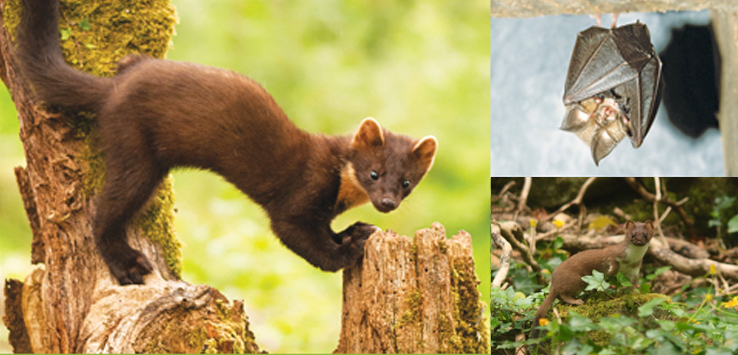Arden Wood Pine Marten Project
Woodlands for wildlife – creating artificial denning sites for pine martens
(Original article written for Native Woodland Trust Magazine, Autumn 2018)
Ireland’s wild places and scenic countryside provide food and shelter for our native wildlife, or so we believe they should because this is the natural order of things. What happens, however, when truth and theory are not aligned, and so many habitats have been altered beyond the natural requirements of the species? Wild animals that have existed on the island for thousands of years may strive to adjust to the new normal, and people can encounter them more than in times gone by, sometimes unwillingly. Can we find ways to help our wildlife adapt or do we count on it to adjust on its own to an ever-changing countryside.
A recent collaboration between The Native Woodland Trust (NWT) and the Vincent Wildlife Trust (VWT) created artificial dens for pine martens in two woodlands in the Midlands. For the pine marten, existing as a woodland specialist in what used to be one of the least wooded countries in Europe can pose some challenges. Ireland’s forest cover declined up to the late 1920s until the introduction of the first Forestry Act. Such deforestation as well as predator control, hunting and poisoning drove pine martens to near extinction until they were legally protected in 1976. Despite encouraging levels of woodland planting – currently the increase in forest cover is among the highest in Europe – Irish forests are of a relatively young age and dominated by conifer. The availability of complex forests with well-developed ground and shrub layers, tree cavities and deadwood are still a way off. Natural tree holes are readily available on the continent where there are nine species of woodpecker. Ireland on the other hand, has no resident woodpeckers – though great spotted woodpeckers have been recorded breeding in Ireland since 2008, which may bode well for the future. This scarcity of natural den sites may be why pine martens sometimes use attics of houses: a trait that has brought the animal into contact and, in some cases, conflict with residents and can be distressful for those involved.
Some time ago, while visiting Arden Wood in Westmeath, NWT officers noticed pine marten droppings (known as scats). Marten usually leave scats on high points such as tree stumps or fallen logs, to mark their territory. The scats are relatively distinct – generally dark and coiled, measuring 4-12cm in length, and surprisingly pleasant and floral smelling. Their form reflects what the animal has eaten, and with the marten’s highly seasonal diet it can be comprised of the remains of berries, insects, amphibians, small mammals, birds or carrion. The NWT set up a camera in the woodland to confirm the presence of martens and captured photographic evidence of the elusive mammal (see Photo: Original sighting at Arden Wood, Photo credit: Native Woodland Trust). Martens are instantly recognisable by their cream-coloured throat patch, which surprisingly is unique to each individual marten, thereby allowing easy identification of individuals. They are the size of a small cat with dark brown fur and a bushy tail, the luxurious coat becomes bushier and browner in winter, turning darker and sleeker in summer.
Following the finding of evidence of the presence of pine martens, The NWT and VWT came together to form the ‘Arden Wood Pine Marten Project.’ Arden Wood is seven acres of mature broadleaf woodland that is potentially an area of ancient woodland dating back more than 350 years. Our goals were clear – erect a den box in Arden wood and at an adjacent woodland where scats had also been discovered, study any future occupants using trail cameras, and engage with people in the local area about the ecology of the pine marten in Ireland through the project. With funding from Local Agenda 21, we purchased two wooden pine marten den boxes and two motion-triggered wildlife cameras to remotely observe any activity.
Pine martens are woodland specialists and expert climbers. They prefer to stay off the ground, denning in a snug tree hole protected from inclement weather and safe from predators such as foxes. Rock crevices, underground burrows, squirrel dreys and log piles can also serve as dens for breeding. Den boxes replicate the features of a natural denning site – there are three internal chambers, the outer two are accessed from the back of the box facing the tree trunk and the middle chamber provides a draught free space. After a site visit to choose a suitable location for the den box – ideally a mature tree in an undisturbed location with a fallen log nearby, a favoured feature for a marten to run along, we carried our ladder, ropes, harnesses, den box, camera and helmets to the bottom of the tree and set up a pulley system. I remember the process of tying the den box into place clearly. I perched on top of the ladder five metres above the forest floor, secured with ropes, gazing at the snow falling around me on that February afternoon and feeling the harsh biting cold. The discomfort seems insignificant now and it has become a memorable moment for me. After positioning the camera on an adjacent tree, we left the woods in the hope that we had done enough: we had created a safe, secure den for a marten needing somewhere to give birth to her kits. Pine martens are solitary creatures and only come together in late summer and autumn to mate. The female becomes pregnant the following spring when conditions are favourable, and she will give birth to two or three kits in April. They are born blind, hairless and completely dependent on their mother for their first six weeks of life, remaining with her for six to sixteen months.
Reconvening for our first check, we longed to find that our boxes had been turned into cosy dens by a female pine marten, but wildlife is just that – wild – so we could only hope. Retrieving a memory card from a trail camera is always exhilarating but as we scrolled through endless photographs and videos we started to lose faith. A pile of scats on the roof of the box is always a giveaway, but there were no such signs on the box or on the forest floor. Just as it seemed that all our efforts had been in vain, we spied it: a photograph of a sleek pine marten, almost hidden on the trunk, climbing nimbly down from the den box!
Our second den box in a nearby woodland yielded even more unexpected treasure. We sat huddled around the laptop beneath the tree, whispering and eagerly checking through each recording and keeping our voices low to avoid disturbing any potential occupants. What excitement when we watched footage of not one, but two kits coming out of the den box! The animals exhibited interesting behaviour: we had placed the box above a limb leading away from the tree – giving the type of aerial walkway that is a preference of pine martens. This decision was wise because this family of martens rarely went up the main trunk but almost always ventured out along the limb. The trail camera also recorded red squirrels on the box itself and a bat flying about the den box – a real bonus!
Arden Wood Pine Marten Project was a successful collaboration. It gave us study sites to deepen our knowledge of pine marten behaviour and helped us to better understand the value of creating artificial denning sites for these elusive creatures. The den boxes are cost-effective and were readily used by female martens in the area, providing much needed secure natal dens and ensuring that the species remained in its natural habitat – the woods. Our landscape has changed and our wildlife is adaptable but is also dependent on the most traditional of habitats – woodlands and hedgerows – for food and shelter, and for survival. Exploring ways to meet our needs and where our wildlife can also endure is not only crucial, it is entirely possible.
Watch the accompanying video.
*Filming of den boxes was carried out under licence from the National Parks and Wildlife Service.





